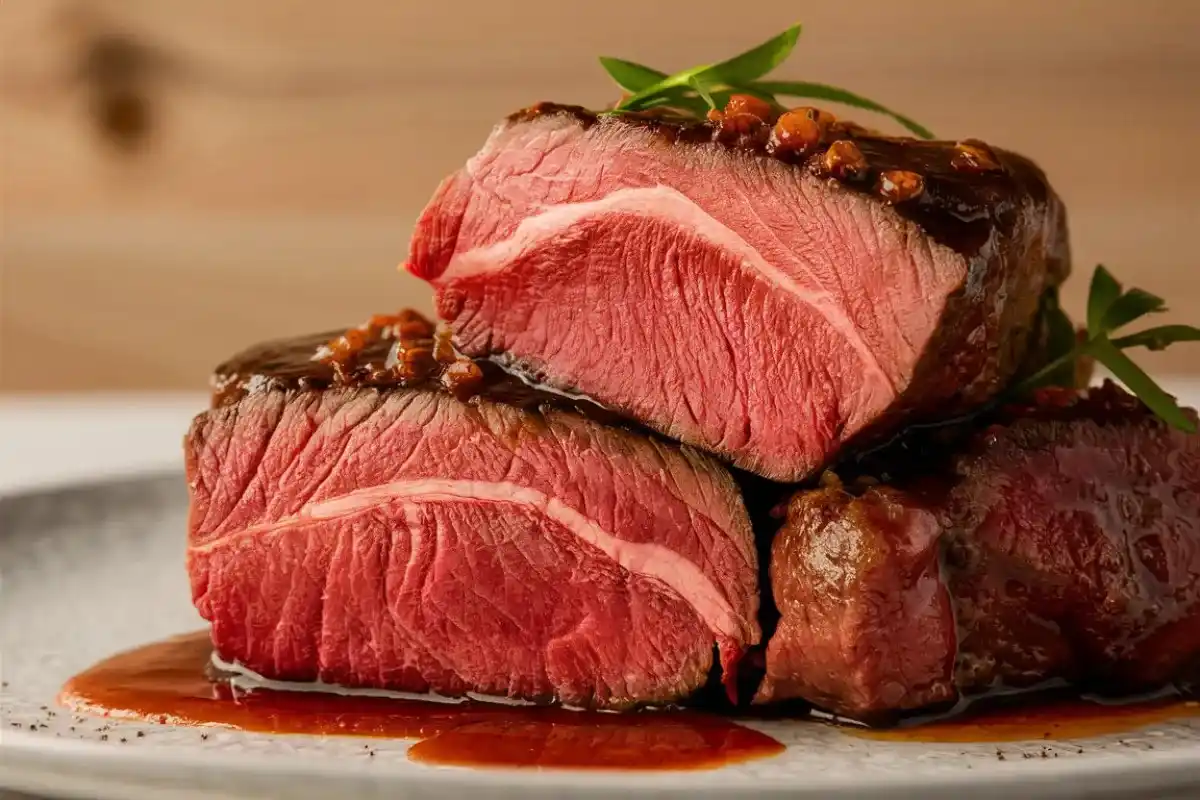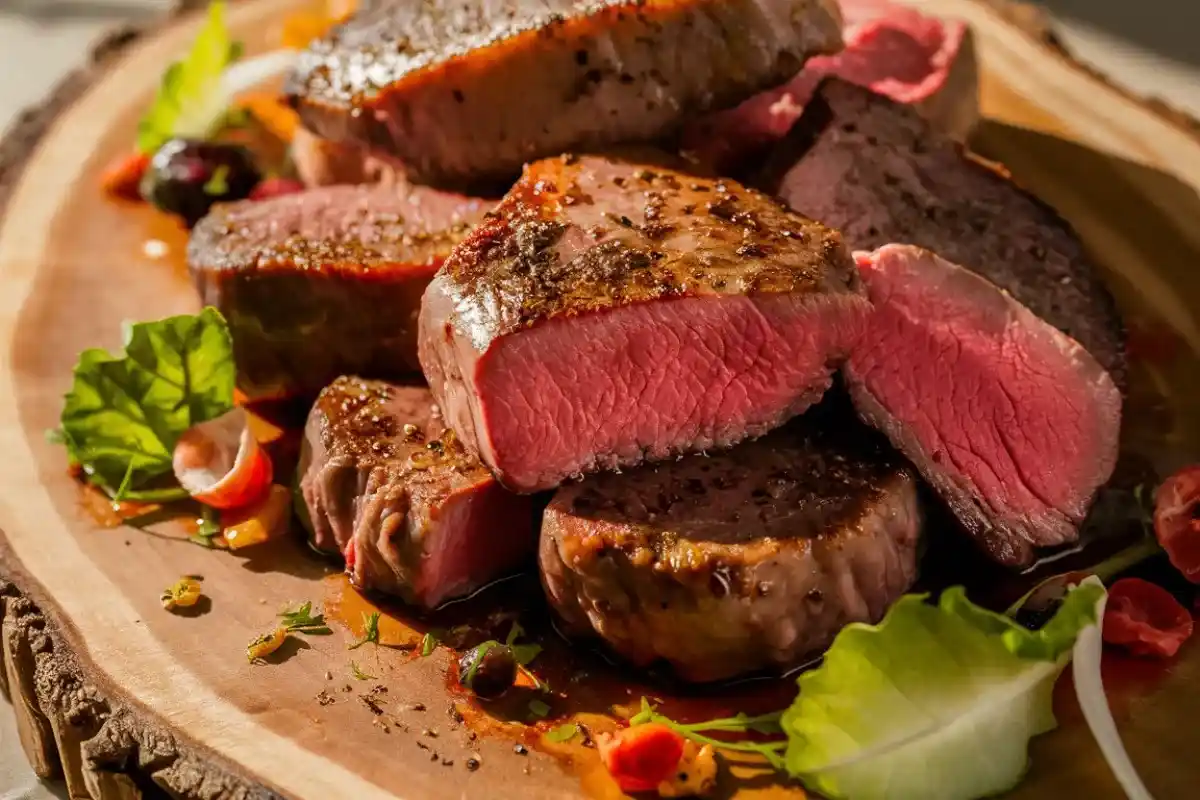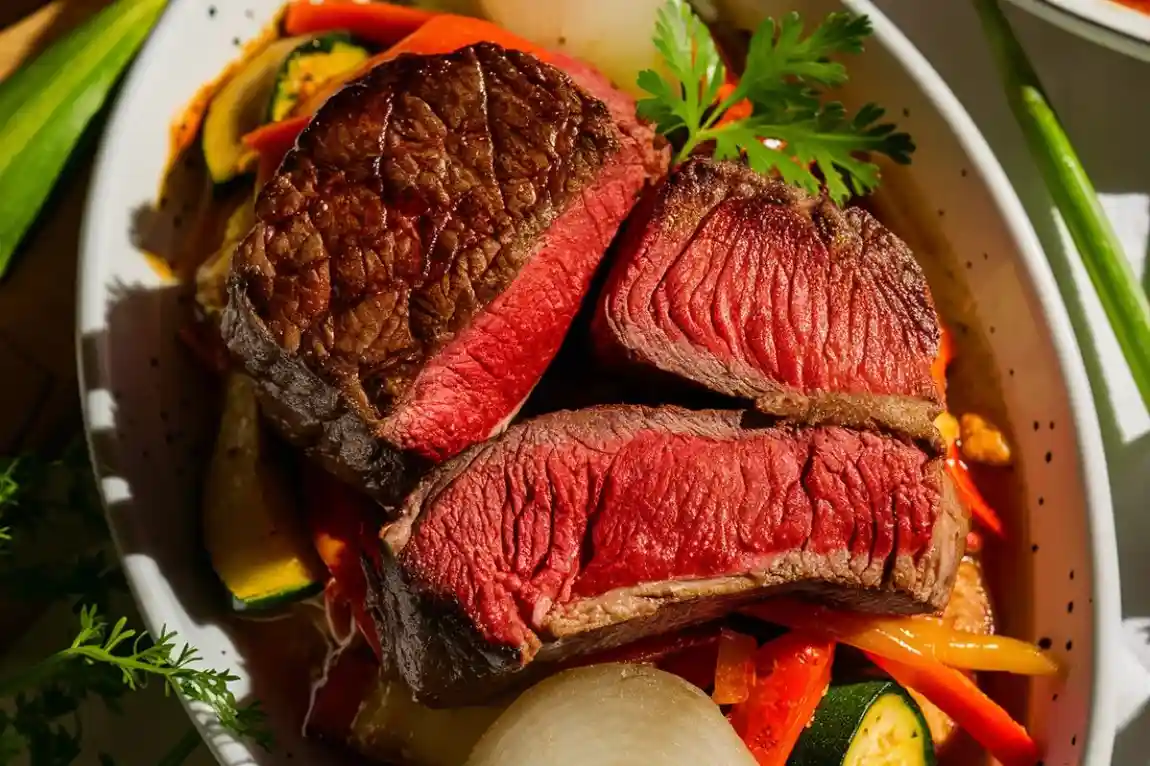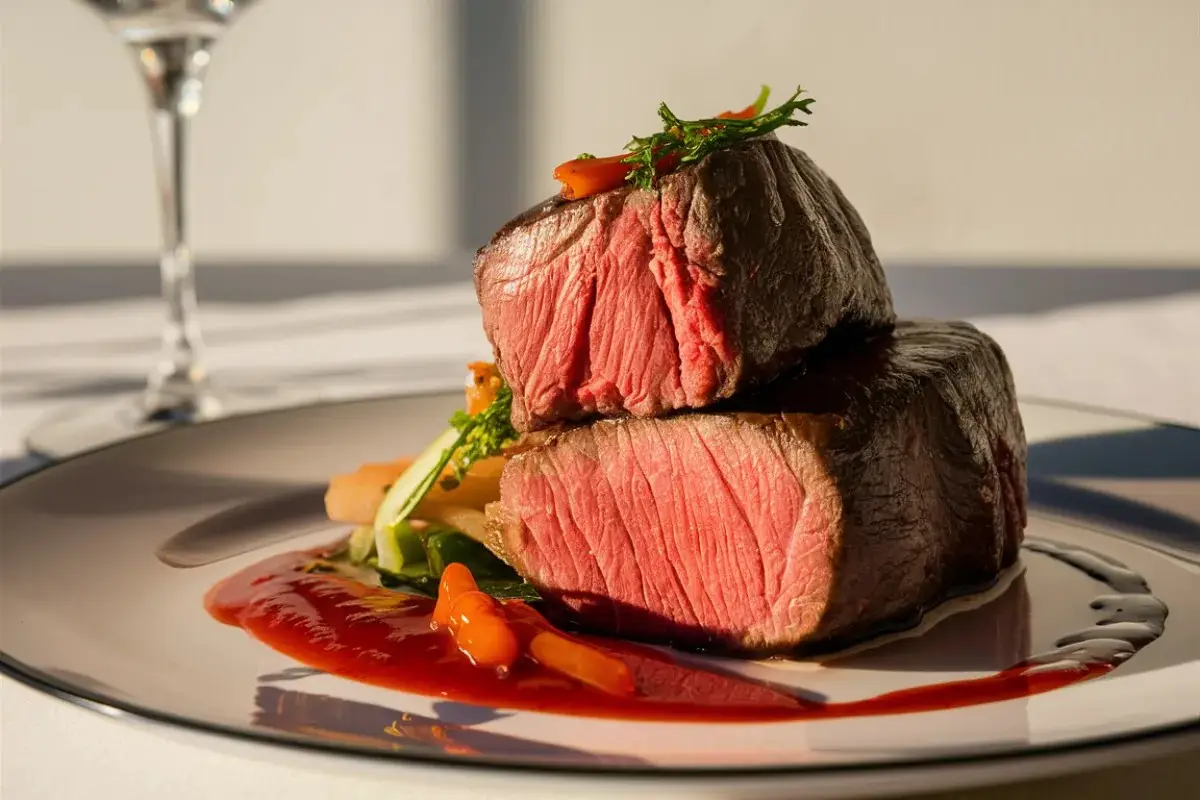Pepper steak is a dish that blends tender, thinly sliced beef with vibrant bell peppers, onions, and a rich, savory sauce to create a meal that’s both hearty and full of flavor. Whether you’re cooking for a family dinner or trying to impress guests, Choosing the best cut of meat for pepper steak is essential for creating a tender and flavorful dish that everyone will love.
In this comprehensive guide, we’ll explore the top recommended cuts of meat for pepper steak, delve into essential preparation tips, and answer frequently asked questions to help you create the perfect dish. We’ll also discuss common mistakes to avoid, offer serving suggestions, and provide links to other useful recipes that complement your pepper steak meal. By the end of this article, you’ll have everything you need to make a delicious and memorable pepper steak.
Why Choosing the Best Cut of Meat for Pepper Steak Matters

Choosing the right cut of meat is the foundation of a great pepper steak. The texture, flavor, and overall success of the dish heavily depend on the quality of the beef you select. A well-chosen cut will be tender and flavorful, while a poor choice can result in a tough, chewy dish that lacks the desired juiciness.
Key Factors to Consider
When selecting the meat for your pepper steak, there are several key factors to consider:
- Tenderness: The cut should be tender enough to cook quickly without becoming tough. Cuts with minimal connective tissue are ideal for this dish.
- Marbling: Marbling refers to the white streaks of fat within the muscle of the meat. More marbling typically means more flavor, as the fat melts during cooking and infuses the meat with richness.
- Flavor Profile: The meat’s natural flavor should complement the dish’s other ingredients, particularly the savory sauce and bell peppers.
Understanding why the best cut of meat for pepper steak matters will help you achieve the perfect texture and flavor.
When deciding on the best meat for your pepper steak, keep in mind that not all cuts are created equal. Some, like flank steak, are lean but still tender, making them ideal for quick cooking. For a detailed guide on selecting the best steak, you might find this perfect cut of steak resource helpful.
Top Recommended Cuts for the Best Pepper Steak
When selecting the best cut of meat for pepper steak, consider these options: flank steak, top sirloin, and round steak.
Flank Steak: A Top Choice for Pepper Steak
Characteristics: Flank steak is one of the most popular choices for pepper steak due to its balance of affordability, flavor, and tenderness. This cut comes from the abdominal muscles of the cow, making it a lean option with a pronounced beefy flavor. Its thin grain makes it ideal for slicing against the grain, which is crucial for maximizing tenderness.
Cooking Tips:
- Slicing: Always slice the meat thinly against the grain. This technique breaks down the muscle fibers, making each bite more tender.
- Marinating: Flank steak benefits greatly from marination. A good marinade can tenderize the meat further and infuse it with additional flavors. Consider a marinade that includes soy sauce, garlic, and a bit of sugar for a perfect balance.
- Quick Cooking: Cook the steak quickly over high heat. Sear flank steak on each side for a short period to avoid overcooking, which can make it tough.
Flank steak is versatile and can be used in various other dishes. If you’re interested in exploring more recipes that utilize flank steak, you might want to check out different beef jerky recipes, where the same principles of marination and quick cooking apply.
Top Sirloin: Another Best Cut of Meat for Pepper Steak
Characteristics: Top sirloin is another excellent choice for pepper steak. It’s a cut from the back of the cow, just above the tenderloin. People know top sirloin for its balance of tenderness and robust flavor. While it’s slightly more expensive than flank steak, it’s still relatively affordable compared to premium cuts like ribeye or tenderloin.
Cooking Tips:
- Slicing: Like flank steak, top sirloin should be sliced thinly against the grain. This technique helps in maintaining the meat’s tenderness.
- Quick Sear: Top sirloin benefits from a quick sear on high heat. This method ensures that the outside develops a nice crust while the inside remains juicy and flavorful.
- Minimal Marination: Unlike flank steak, top sirloin does not require extensive marination due to its natural tenderness. A simple rub with salt, pepper, and olive oil is often sufficient.
For those who enjoy experimenting with different beef cuts, top sirloin can be an excellent choice for other dishes as well. Exploring different cooking methods for chuck roast can give you a broader understanding of how various beef cuts can be adapted to different recipes.
For a recipe that utilizes one of these cuts effectively, you can refer to this pepper steak stir-fry guide, which showcases the ease and flavor of a well-prepared pepper steak.
If you’re also a fan of ground beef, exploring ground beef recipes can offer some variety to your weekly meal planning, giving you delicious options that complement your pepper steak endeavors.
Round Steak: A Lean Option for Pepper Steak
Characteristics: Round steak is a lean cut from the rear leg of the cow. It’s typically less expensive than both flank steak and top sirloin but still offers a robust flavor. Because round steak is leaner, it requires careful preparation to avoid becoming tough.
Cooking Tips:
- Marinating: Marinating is essential for round steak. A marinade with acidic components such as vinegar or citrus juice can help break down the meat’s fibers, making it more tender.
- Thin Slicing: As with the other cuts, slice the round steak thinly against the grain to enhance tenderness.
- Quick Cooking: Cook the round steak quickly over high heat to prevent it from drying out. This cut is best when cooked to medium-rare or medium.
Round steak suits not only pepper steak but also other dishes where lean beef is preferred. If you’re curious about other lean cuts and their uses, exploring recipes with ground beef can offer some insights into how lean beef can be used creatively in your kitchen.
Avoiding Tough Cuts: Ensuring You Select the Best Cut for Pepper Steak

While the cuts mentioned above are ideal for pepper steak, avoid certain cuts of beef due to their toughness and the specific cooking methods they require. These cuts often contain more connective tissue, which needs slow cooking to break down something that doesn’t align with the quick, high-heat cooking method used for pepper steak.
Chuck Steak
Why to Avoid: Chuck steak comes from the shoulder area of the cow and is known for its rich flavor. However, it also contains a significant amount of connective tissue, which makes it tough and chewy if not cooked slowly. Chuck steak is best suited for braising or slow cooking, where the long cooking time allows the connective tissue to break down. Avoiding certain cuts can ensure that you always use the best cut of meat for pepper steak
Alternative Uses: Chuck steak is ideal for slow-cooked dishes like pot roast or beef stew, where it has time to tenderize. For those interested in exploring chuck steak further, understanding what chuck roast is good for can provide valuable insights into how to make the most of this flavorful cut.
Shank
Why to Avoid: The shank comes from the leg portion of the cow and is one of the toughest cuts of beef. It contains a lot of collagen, which requires slow cooking to break down into a gelatinous texture. People typically use shank in dishes like osso buco or beef stock, where its rich flavor and texture can be fully appreciated after hours of cooking.
Alternative Uses: If you do choose to use shank, consider slow-cooked recipes that allow the meat to tenderize over time. It’s not suitable for quick, high-heat dishes like pepper steak.
Preparation Tips for the Best Cut of Meat for Pepper Steak
To ensure your pepper steak turns out perfectly, it’s important to follow the right preparation techniques. Here are some tips that will help you achieve the best results:
Marinating the Meat
Marinating is one of the most effective ways to enhance the flavor and tenderness of your steak. A good marinade should contain a balance of acid (such as vinegar or citrus juice), oil, and seasoning. The acid helps break down the meat’s fibers, making it more tender, while the oil adds moisture and the seasoning infuses flavor.
Tips for Marinating:
- Duration: Marinate the meat for at least 30 minutes, but no longer than 24 hours. Over-marinating can make the meat mushy.
- Ingredients: A simple marinade can include soy sauce, garlic, ginger, brown sugar, and a splash of lemon juice. For a spicier kick, consider adding red pepper flakes or sriracha.
- Marinating Method: Use a resealable plastic bag or a glass dish for marinating. Ensure the meat is fully coated and occasionally turn it to distribute the marinade evenly.
If you enjoy marinating meats and experimenting with flavors, exploring recipes that use rotisserie chicken can offer additional inspiration for creating marinades that complement various types of meat.
Slicing the Meat
How you slice the meat is crucial to the final texture of your pepper steak. Slicing the meat against the grain shortens the muscle fibers, resulting in a more tender bite.
Tips for Slicing:
- Against the Grain: Look at the direction of the muscle fibers (the grain) in the meat. Slice perpendicular to the grain to create shorter, more tender pieces.
- Thin Slices: Thin slices cook more quickly and evenly, which is essential for maintaining tenderness in a dish that cooks rapidly over high heat.
- Sharp Knife: Use a sharp knife to ensure clean cuts. A dull knife can tear the meat, leading to uneven cooking.
For those who love incorporating different types of meat into their cooking, learning how to jazz up boring pasta with unique meat slices and preparation techniques can elevate your everyday meals.
High Heat Cooking
Pepper steak should be cooked quickly over high heat to achieve the best texture. High heat allows the meat to sear on the outside while remaining tender and juicy on the inside.
Tips for High Heat Cooking:
- Preheat the Pan: Ensure your pan is fully heated before adding the meat. This step helps in achieving a good sear, which locks in the juices and flavors.
- Do Not Overcrowd: Cook the meat in batches if necessary. Overcrowding the pan can cause the meat to steam rather than sear, resulting in a less desirable texture.
- Quick Cooking: Depending on the thickness of your slices, the meat should only take a few minutes per side. Keep a close eye to avoid overcooking.
High-heat cooking is also effective for other dishes, such as those involving chicken. If you’re interested in learning how to improve rotisserie chicken, you’ll find that similar principles apply, such as quick cooking and achieving a perfect sear.
Serving Suggestions for Your Best Cut of Meat for Pepper Steak

Pepper steak is a versatile dish that pairs well with a variety of sides, making it a perfect centerpiece for a complete meal. Here are some serving suggestions that can enhance your pepper steak experience:
Rice
Rice is a classic accompaniment to pepper steak, as it helps to soak up the savory sauce. Both white and brown rice work well, depending on your preference.
Serving Tip: To add more flavor to your rice, consider cooking it in beef broth instead of water. You can also stir in some sautéed onions or garlic for an extra burst of flavor.
Noodles
For an Asian-inspired twist, serve your pepper steak over noodles. Wide rice noodles or egg noodles work particularly well with the rich sauce of pepper steak.
Serving Tip: Toss the noodles in a bit of sesame oil and soy sauce before adding the pepper steak to enhance the overall flavor profile.
Vegetables
Incorporating additional vegetables into your pepper steak dish can add color, texture, and nutritional value. Bell peppers and onions are a must, but you can also add snap peas, broccoli, or carrots.
Serving Tip: Stir-fry the vegetables separately before combining them with the meat to ensure they retain their crispness and vibrant color.
Alternative Pairings
If you’re looking to try something different, consider pairing your pepper steak with more unique sides like roasted sweet potatoes or a fresh green salad. These alternatives can provide a balance of flavors and textures that complement the richness of the steak.
For inspiration on side dishes and complementary flavors, exploring pasta salad recipes can offer some fresh ideas, especially if you’re looking to serve a larger meal or buffet.
Frequently Asked Questions
What is the best cut of meat for pepper steak?
The best cuts for pepper steak are flank steak, top sirloin, and round steak due to their tenderness, flavor, and quick cooking times.
Can I use frozen meat for pepper steak?
While fresh meat is preferable, if you must use frozen meat, fully thaw it before cooking to retain its texture and tenderness.
Is pepper steak spicy?
Pepper steak is not inherently spicy. The “pepper” in its name refers to bell peppers, not hot chili peppers. However, you can add spice to the dish by incorporating ingredients like chili flakes or sriracha into the sauce.
How do I make my pepper steak tender?
Marinating the meat and slicing it thinly against the grain are key to ensuring tenderness. Additionally, avoid overcooking the meat; quick, high-heat cooking is ideal.
What is the difference between pepper steak and beef stir-fry?
Pepper steak specifically features bell peppers and a savory sauce, while beef stir-fry can include a variety of vegetables and sauces. The techniques are similar, but the flavor profiles can differ based on the ingredients used.
Frequently Made Mistakes
Avoid these common pitfalls to ensure your pepper steak turns out perfect:
Overcooking the Meat
One of the most common mistakes when making pepper steak is overcooking the meat. This dish requires quick cooking over high heat to ensure that the steak remains tender and juicy. Overcooking can cause the meat to become tough and dry, detracting from the overall quality of the dish.
Tip: Pay close attention to the cooking time and don’t be afraid to remove the meat from the pan as soon as it reaches the desired level of doneness. Remember that the steak will continue to cook slightly after being removed from the heat.
Using the Wrong Cut
Another frequent mistake is using the wrong cut of beef. Tough cuts like chuck steak or shank, which require long, slow cooking, are not suitable for pepper steak. These cuts can result in a chewy, unpleasant texture if cooked quickly.
Tip: Stick to cuts like flank steak, top sirloin, or round steak, which people know for their tenderness when cooked over high heat.
Skipping the Marinade
Marinating the meat is crucial for both flavor and tenderness. Skipping this step can result in a less flavorful dish and a tougher texture.
Tip: Even a short marination of 30 minutes can make a significant difference in the final dish. Aim for a marinade that balances acidity, sweetness, and seasoning for the best results.
Conclusion
By choosing the right cut of meat and following these preparation tips, you can create a pepper steak that is tender, flavorful, and sure to impress. Whether you opt for flank steak, top sirloin, or round steak, taking the time to marinate, slice, and cook the meat properly will make all the difference. Serve your pepper steak with complementary sides like rice, noodles, or vegetables, and enjoy a delicious meal that’s perfect for any occasion.
This guide has provided a comprehensive overview of how to make the best pepper steak. By avoiding common mistakes and using the recommended techniques, you’ll be well on your way to mastering this classic dish. If you’re looking for more culinary inspiration, be sure to explore the linked recipes and guides to expand your cooking repertoire.

